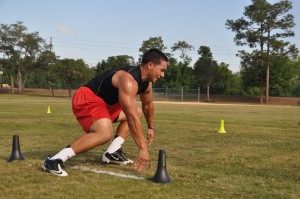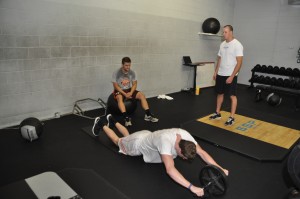By: Jonathan TaylorSports Performance SpecialistSpectrum Sports Performance The human body was made to move! Starting when we are very young, the body begins to progressively learn how to move through a series of rolling, pulling, pushing, crawling, and eventually walking techniques. Through the need of getting from here to there, a baby’s body mechanics begin to fire in proper sequence, thus coordinating movement. Squatting, extending the hip, pushing, pulling, and rotating are all natural movements that require various forms of mobility and stability throughout the kinetic chain. But just as we have learned how to move based on various needs as children, stressful lifestyle, sedentary occupation, and lack of exercise have caused many individuals to unlearn these basic motor patterns, forcing them into coping with debilitating, chronic pain throughout many of the body’s joints. However, through proper exercise selection, one can work towards reversing many of these ailments, but it does require something: actually moving!
The human body was made to move! Starting when we are very young, the body begins to progressively learn how to move through a series of rolling, pulling, pushing, crawling, and eventually walking techniques. Through the need of getting from here to there, a baby’s body mechanics begin to fire in proper sequence, thus coordinating movement. Squatting, extending the hip, pushing, pulling, and rotating are all natural movements that require various forms of mobility and stability throughout the kinetic chain. But just as we have learned how to move based on various needs as children, stressful lifestyle, sedentary occupation, and lack of exercise have caused many individuals to unlearn these basic motor patterns, forcing them into coping with debilitating, chronic pain throughout many of the body’s joints. However, through proper exercise selection, one can work towards reversing many of these ailments, but it does require something: actually moving!
When surveying the most common activity people consistently engage in, it is summed up in a sedentary lifestyle, or not doing a whole lot of moving. Think about it, we wake up, we begin our day by sitting and eating breakfast, we then sit in our vehicles to get to work; once at work, we proceed to sit for eight hours or more busying ourselves with tasks; after completing the day, we then get back in our cars to sit while driving home, come and sit for dinner, and before bed, we stare at the TV or computer just before bed on our bum. Common thread: We sit all day long! Our lifestyle is the biggest detriment as to why our bodies are so dysfunctional.
Let’s dissect this a little bit: when sitting, the ankles don’t usually move past a 90 degree angle, causing stiff or immobile ankle joints, or calf tightness. Working up the kinetic chain to the knees, they stay bent, causing shortened or tight hamstrings. Next, the hip is flexed, also causing shortened or tight hip flexors. Moving up further, the shoulders are pulled forward due to the many hours of bad posture, tight pectorals, and lack of muscular endurance in the scapular retractors, causing a lot of undesired movement through the lumbar spine to compensate. Lastly, sitting produces inactivity in the glute muscles, i.e. you don’t use them, which is a major cause of low back pain. The contribution of this type of lifestyle doesn’t help at all when it comes to improving and maintaining proper, coordinated movement. To reverse this decay, we have to get on our feet and start moving, or lifestyle will soon send you to the infirmary.
 So, when it comes to working out, shouldn’t one be able to graze into a gym to get help with these movement abnormalities? Hardly! If you were to take a tour in many fitness facilities and gyms across the country, what is the number thing that clogs up the carpeted space between all the mirrored walls? Yep, you guessed it, “exercise machines” that make you…drum roll please…sit! So, to help reverse the effect of sitting, I will chose to engage in more sitting!! The very machines that are promising to help with “muscle tone,” are the very things that reinforce all the bad, bodily movement compensations. So here comes my most obvious recommendation: Stop sitting! Granted we have to sit in our day, but when working out stay on your feet. The only time you should be sitting is at the conclusion of your workout trying to catch your breath from the intense session.
So, when it comes to working out, shouldn’t one be able to graze into a gym to get help with these movement abnormalities? Hardly! If you were to take a tour in many fitness facilities and gyms across the country, what is the number thing that clogs up the carpeted space between all the mirrored walls? Yep, you guessed it, “exercise machines” that make you…drum roll please…sit! So, to help reverse the effect of sitting, I will chose to engage in more sitting!! The very machines that are promising to help with “muscle tone,” are the very things that reinforce all the bad, bodily movement compensations. So here comes my most obvious recommendation: Stop sitting! Granted we have to sit in our day, but when working out stay on your feet. The only time you should be sitting is at the conclusion of your workout trying to catch your breath from the intense session.
Included here is a brief, but hardly exhaustive guide to exercise that will help combat the era of sitting adults. First, start by engaging one of the most important but unused muscles on the body: the glute, i.e. butt, muscles. Simple lie on your back, push your hips up, squeeze your bum as hard as you can, and hold for 30-60 seconds. Make sure and push through your heels into the ground and not your toes. For more of a challenge, lift one leg off the ground into a single leg, glute bridge hold. Next, actively warm up (moving muscles through a range of motion with no more than a 2-3 second hold) the hip flexors, hamstrings, chest, and calves, which are all common areas of tightness due to sitting all day. For hip flexors, get into a half-kneeling position and reach up to the ceiling as high as you can. You will feel the front of the hip open up and stretch. For the hamstrings, lie on your back, bring your knee into your chest, and then extend the knee all the way up to get the leg as straight as possible. To engage the calf, point your toe to the ceiling, then flex it back towards your shin. Repeat for 5-6 repetitions per leg. For the chest, simple arms hugs are good to increase blood flow and get an active stretch. Hug yourself, open the arms, and repeat.
After warming up, choose movements that will engage all the major muscles and stress proper movement, not just isolating a specific body part. Here are few choices that can be easily found on any Internet, search engine:
Movement: Extending the Hip (Glutes, Hamstrings)
– Romanian Deadlift (bilateral: two legs)
– Romanian Deadlift (unilateral: one leg)
– Physioball or Swiss ball Hamstring Curls (bilateral: two legs)
– Physioball or Swiss ball Hamstring Curls (unilateral: one leg)
– Hip Extension (bilateral: two legs)
– Hip Extension (unilateral: one leg
Movement: Flexing and Extending the Hip & Knee (Quads, Glutes, Hamstrings)
– Body Weight Squat
– Single Leg Squat
– Front/Back Squat (bilateral: two legs)
– Split Squat (unilateral: one leg)
– Step Up (unilateral: one leg)
Movement: Horizontal/Vertical Pulling (Lats, Traps, Rhomboids, Biceps)
– Supinated Pull Up (Horizontal)
– One arm Back Row (Horizontal)
– Pull Up (Vertical)
– Band Pull Down (Vertical)
*Movement: Horizontal/Vertical Pushing (Pectorals, deltoids, triceps)
– Push Up -> Push Up on Physioball -> Plyometric Push Up (Horizontal)
– Chest Press on Physioball -> Chest Press w/one shoulder off bench (Horizontal)
– Shoulder Press -> Push Press (Vertical)
– Dip (Vertical)
*(When choosing pressing exercises, and especially if short on time, always select vertical pressing over horizontal pressing. Vertical pressing not only works on shoulder strength and stability, but it works on scapular retraction and depression when the arms are fully extended upward, helping posture and muscular endurance.)
Movement: Lumbar Stability (all the many layers of abdominal muscles)
– Lateral Pillar -> Lat. Pillar with Trunk Rotation -> Lat. Pillar with lateral flexion
– Roll Outs
– Deadbugs
– Physioball Pillar -> Physioball “Stir the Pot”
 In conclusion, due to the shift in our society from relatively active jobs requiring standing, stamina and strength, to occupations that force many to sit all day, expend little energy, and facilitate only slight movement, we have contracted detrimental, compensating, movement patterns that can lead to various forms of chronic pain. Exercises that further reinforce these compensatory patterns by sitting while workout out, do little in helping the problem. However, when choosing appropriate, movement-based exercises, one can help reverse the effects of a sedentary lifestyle. Bottom line: stay on your feet and train movements, your body will thank you later.
In conclusion, due to the shift in our society from relatively active jobs requiring standing, stamina and strength, to occupations that force many to sit all day, expend little energy, and facilitate only slight movement, we have contracted detrimental, compensating, movement patterns that can lead to various forms of chronic pain. Exercises that further reinforce these compensatory patterns by sitting while workout out, do little in helping the problem. However, when choosing appropriate, movement-based exercises, one can help reverse the effects of a sedentary lifestyle. Bottom line: stay on your feet and train movements, your body will thank you later.
Leave a Reply